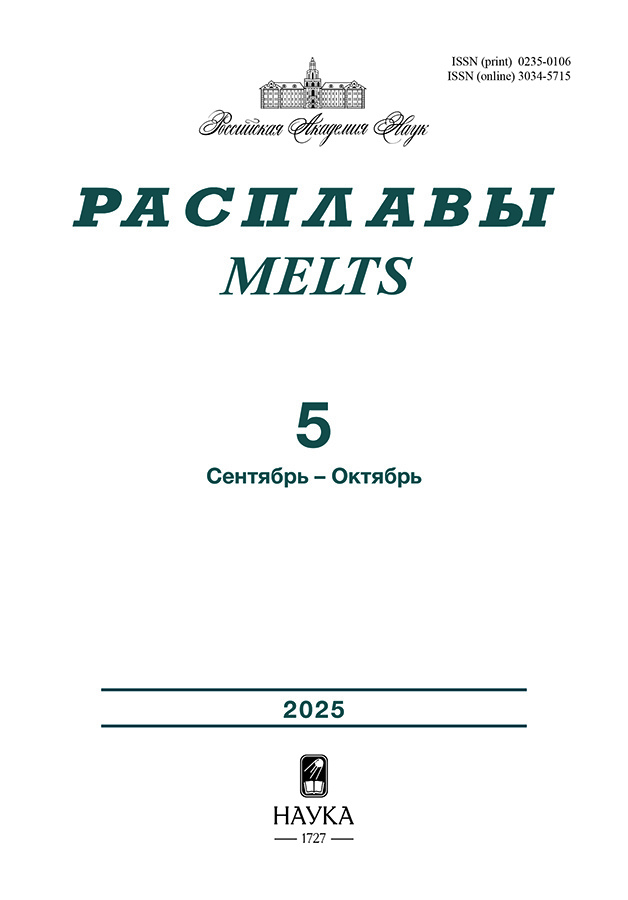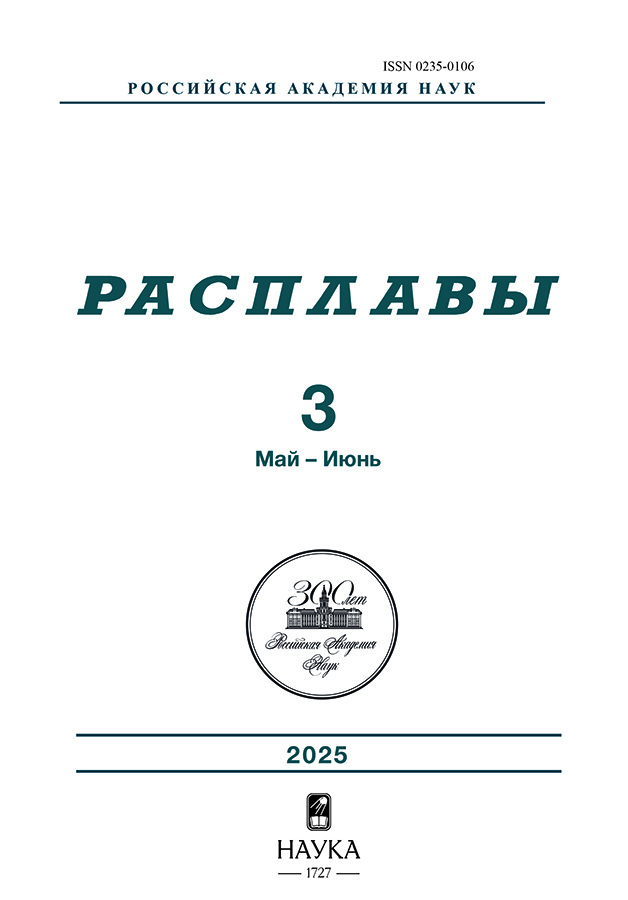Поверхностные свойства оксидно-фторидных соединений, образующихся при алюминотермическом синтезе высокоэнтропийных сплавов
- Авторы: Русских А.С.1, Жилина Е.М.1, Осинкина Т.В.1
-
Учреждения:
- ФГБУН Институт металлургии имени академика Н.А. Ватолина Уральского отделения Российской академии наук
- Выпуск: № 3 (2025)
- Страницы: 205-217
- Раздел: Статьи
- URL: https://rjmseer.com/0235-0106/article/view/686292
- DOI: https://doi.org/10.31857/S0235010625030033
- ID: 686292
Цитировать
Полный текст
Аннотация
В данной работе проведено термодинамическое моделирование и экспериментальное исследование оксидно–фторидной фазы, образующейся при получении высокоэнтропийных тугоплавких, легковесных сплавов системы Al–Ti–Zr–V–Nb методом совместного алюминотермического восстановления из оксидов металлов титана, циркония, ниобия и ванадия. Целью работы было определение оптимальных условий получения таких сплавов и нахождение характеристик фазового разделения. Моделирование показало, что для формирования легковесного и тугоплавкого сплава необходимы температуры не ниже 1600°C и содержание алюминия в диапазоне от 15 до 40 атомных процентов. При этом рекомендуется использовать небольшой избыток алюминия в шихте, чтобы обеспечить переход части алюминия в металлическую фазу. Расчёты поверхностного натяжения и плотности показали значительное различие между металлической и оксидно-фторидной фазами, что способствует оседанию металлического расплава на дно тигля и формированию чёткой границы разделения между двумя фазами. Межфазное натяжение в интервале 1000–1600 мДж/м² обеспечивает минимальное смачивание металлом шлака и снижает количество неметаллических включений в металле, что положительно влияет на качество конечного продукта. Отмечено, что увеличение числа компонентов в расплаве усложняет подбор эмпирических коэффициентов, что ограничивает точность расчета эмпирическим методом. Химический анализ оксидно–фторидной фазы после эксперимента подтвердил наличие в ней оксидов циркония и титана, которые повышают поверхностное натяжение и плотность по сравнению с расчётными значениями. Тем не менее, эти параметры остаются ниже соответствующих значений металлической фазы, что обеспечивает эффективное разделение фаз и формирование цельного металлического слитка без чрезмерного сцепления с оксидно-фторидной фазой. Полученные результаты демонстрируют перспективность выбранных условий для производства высококачественных высокоэнтропийных сплавов и могут быть использованы для дальнейших оценочных расчётов и оптимизации технологических процессов.
Ключевые слова
Полный текст
Об авторах
А. С. Русских
ФГБУН Институт металлургии имени академика Н.А. Ватолина Уральского отделения Российской академии наук
Автор, ответственный за переписку.
Email: russkih_A_S@mail.ru
Россия, г. Екатеринбург
Е. М. Жилина
ФГБУН Институт металлургии имени академика Н.А. Ватолина Уральского отделения Российской академии наук
Email: russkih_A_S@mail.ru
Россия, г. Екатеринбург
Т. В. Осинкина
ФГБУН Институт металлургии имени академика Н.А. Ватолина Уральского отделения Российской академии наук
Email: russkih_A_S@mail.ru
Россия, г. Екатеринбург
Список литературы
- Филатов А.А. и др. Способ получения лигатуры AlZr15 из оксидов // Уральская школа молодых металловедов : материалы XVIII Международной научно-технической Уральской школы-семинара металловедов – молодых ученых, Екатеринбург, 21–23 октября 2017 года / Ответственный редактор: А. А. Попов; Министерство образования и науки. 2017. P. 384–388.
- Zhilina E.M., Krasikov S.A. Surface tension of a titanium-containing oxide–fluoride melt calculated by the polymer theory // Russ. Metall. Maik Nauka-Interperiodica Publishing. 2017. 2017. № 8. P. 642–643.
- Tyushnyakov S.N. et al. Metallothermic Reduction of Natural Cassiterite // Metallurgist. 2021. 65. № 7–8. P. 746–759.
- Mityushova Y.A. et al. Thermodynamic Estimation of the Formation of a High-Entropy Al–Nb–Ti–V–Zr Alloy // Russ. Metall. 2021. 2021. № 2. P. 187–191.
- Zhilina E.M. et al. Possibility of obtaining refractory high-entropy AlTiZrVNb alloys from metal oxides // Russ. Chem. Bull. Springer, 2023. 72. № 4. P. 895–901.
- Ikornikov D.M. et al. Effect of Doping with Si–B on the Structure of Cast Mo–Nb–Cr–V–Ti–Al High-Entropy Alloy Produced by Gravity-Assisted SHS Metallurgy // Int. J. Self-Propagating High-Temperature Synth. Pleiades Publishing, 2024. 33. № 4. P. 330–335.
- Kirakosyan H. et al. The preparation of high-entropy refractory alloys by aluminothermic reduction process // AIP Conf. Proc. American Institute of Physics Inc., 2024. 2989. № 1.
- Kaya F. et al. Thermochemical Modeling-Assisted Synthesis of AlxCoCrFeNiMn (0.5 ≤ x ≤ 3) High-Entropy Alloys via Combustion Method for Soft Magnetic Applications // Mining, Metall. Explor. Springer Science and Business Media Deutschland GmbH, 2025. 42. № 2. P. 465–477.
- Li R.X., Liaw P.K., Zhang Y. Synthesis of AlxCoCrFeNi high-entropy alloys by high-gravity combustion from oxides // Mater. Sci. Eng. A. Elsevier, 2017. 707. P. 668–673.
- HSC Chemistry for Windows – Chemical Reaction and Equilibrium Software with extensive Thermochemical Database, product of Outokumpu Research, Oy, Pori, Finland [Electronic resource]. URL: www.outotec.com/hsc. Загл. с экрана.
- Balakirev V.F. et al. Joint Metallothermic Reduction of Titanium and Rare Refractory Metals of Group V // Russ. J. Non-Ferrous Met. Pleiades journals, 2021. 62. № 2. P. 190–196.
- Арсентьев П.П. и др. Экспериментальные работы по теории металлургических процессов. М.: Металл. 1989. 288 p.
- Мурач Н.Н. Алюминотермия титана. М.: ЦИИНцв. 1958. 51 p.
- Allibert M. et al. Slag Atlas // Slag Atlas. 1995. P. 616.
- Hara S., Ogino K. Density of melts for electroslag remelting // Can. Metall. Q. 1981. 20. № 1. P. 113–116.
- Григорян В.А., Белянчиков Л.Н., Стомахин. А.Я. Теоретические основы электросталеплавильных процессов. Москва: Металлургия, 1987. 272 p.
- Линчевский Б.В. Техника металлургического эксперимента. Москва: Наука., 1979. 256 p.
- Арсентьев П.П., Коледов Л.А. Металлические расплавы и их свойства. М.: Металл. 1976. 376 p.
- Попель С.И. Поверхностные явления в расплавах. М.: Металл. 1994. 440 p.
- Попель С.И., Сотников А.И., Бороненков В.Н. Теория металлургических процессов: учебное пособие для вузов. М.: Металл. 1986. 463 p.
- Попель С.И. Теория металлургических процессов. М.: ВИНИТИ. 1971. 132 p.
- Novakovic R. et al. Surface, dynamic and structural properties of liquid Al – Ti alloys // Appl. Surf. Sci. 2012. 258. P. 3269–3275.
- Kotenkov P.V., Cherepanova L.A., Sterkhov E.V. Thermal and Structural Stability of the TiZrHfNbTa Solid Solution // Russ. Metall. Pleiades Publishing, 2024. 2024. № 4. P. 834–840.
- Xin J. et al. Surface tension calculation of molten slag in SiO2–Al2O3–CaO–MgO systems based on a statistical modelling approach // ISIJ Int. 2019. 59. № 5. P. 759–767.
- Nakajima K. Estimation of surface tension for multicomponent silicate melts // Tetsu-to-Hagané. 1994. 80. № 8. P. 599–604.
Дополнительные файлы















